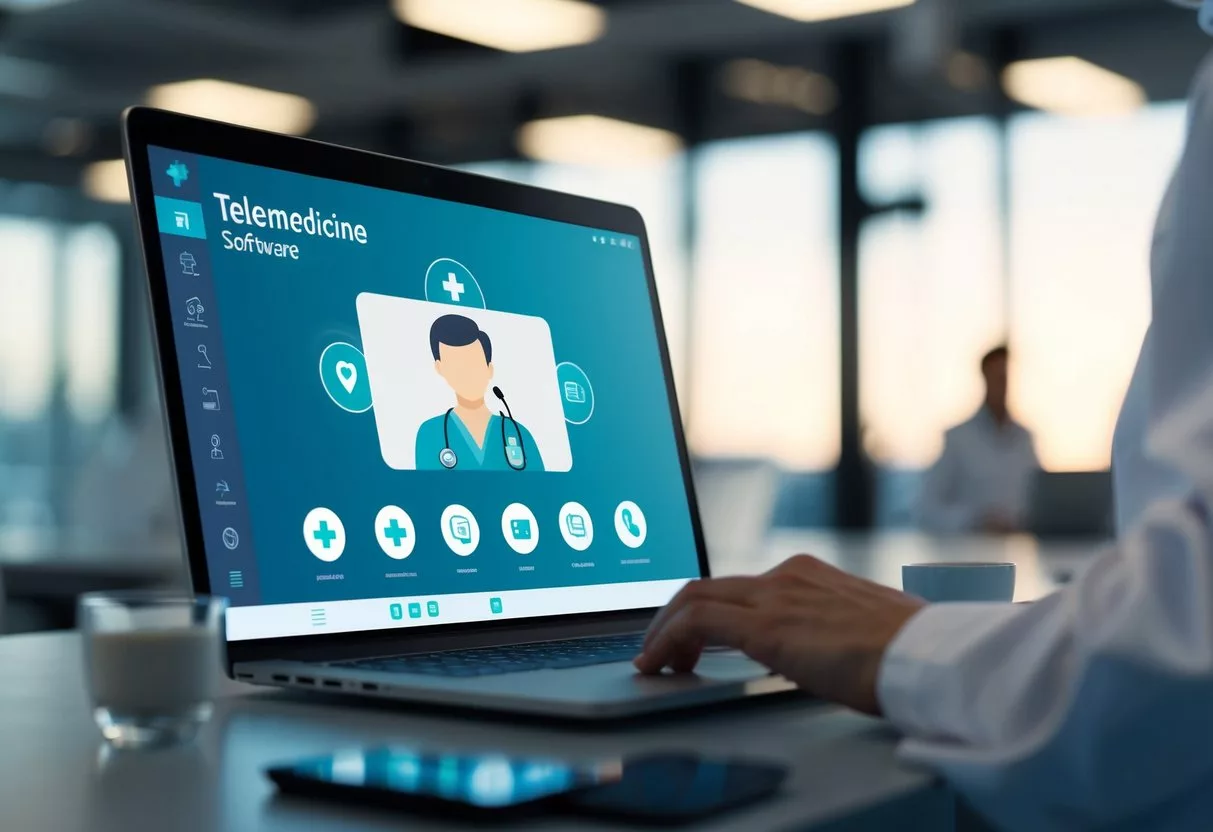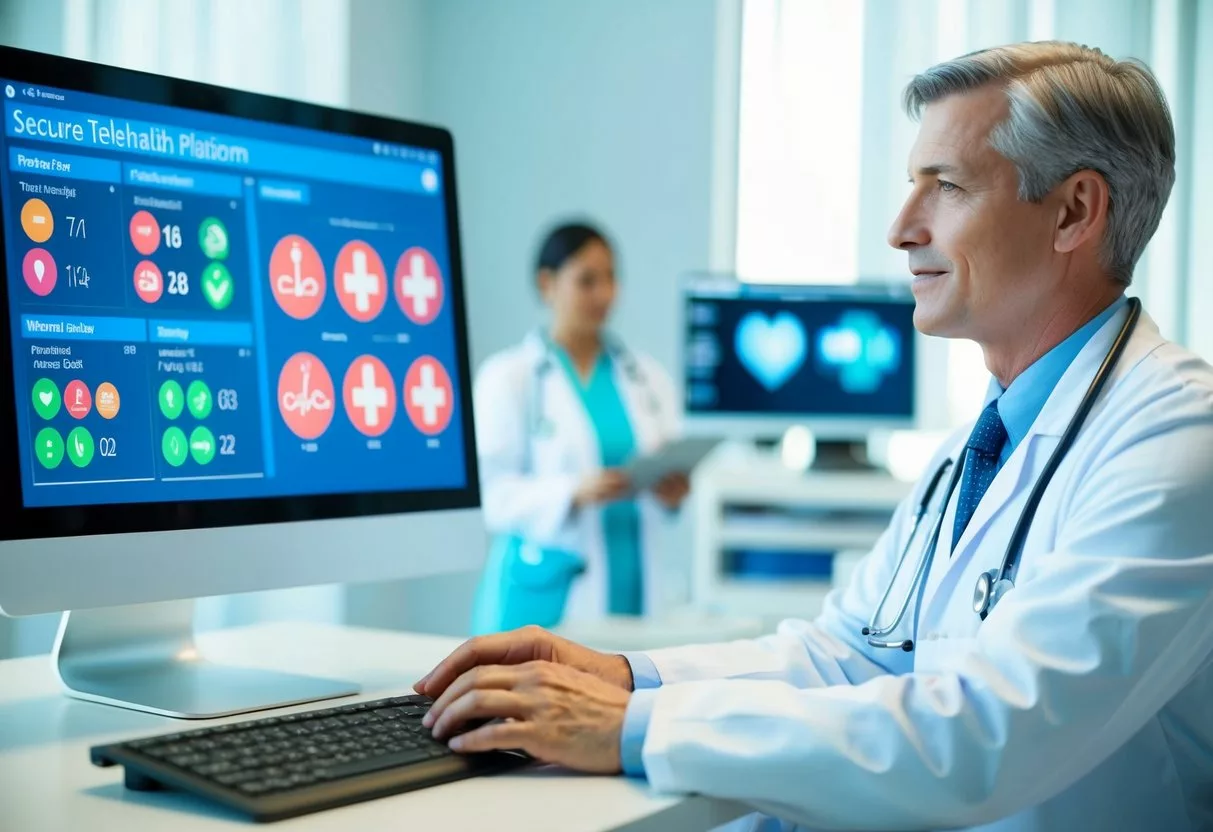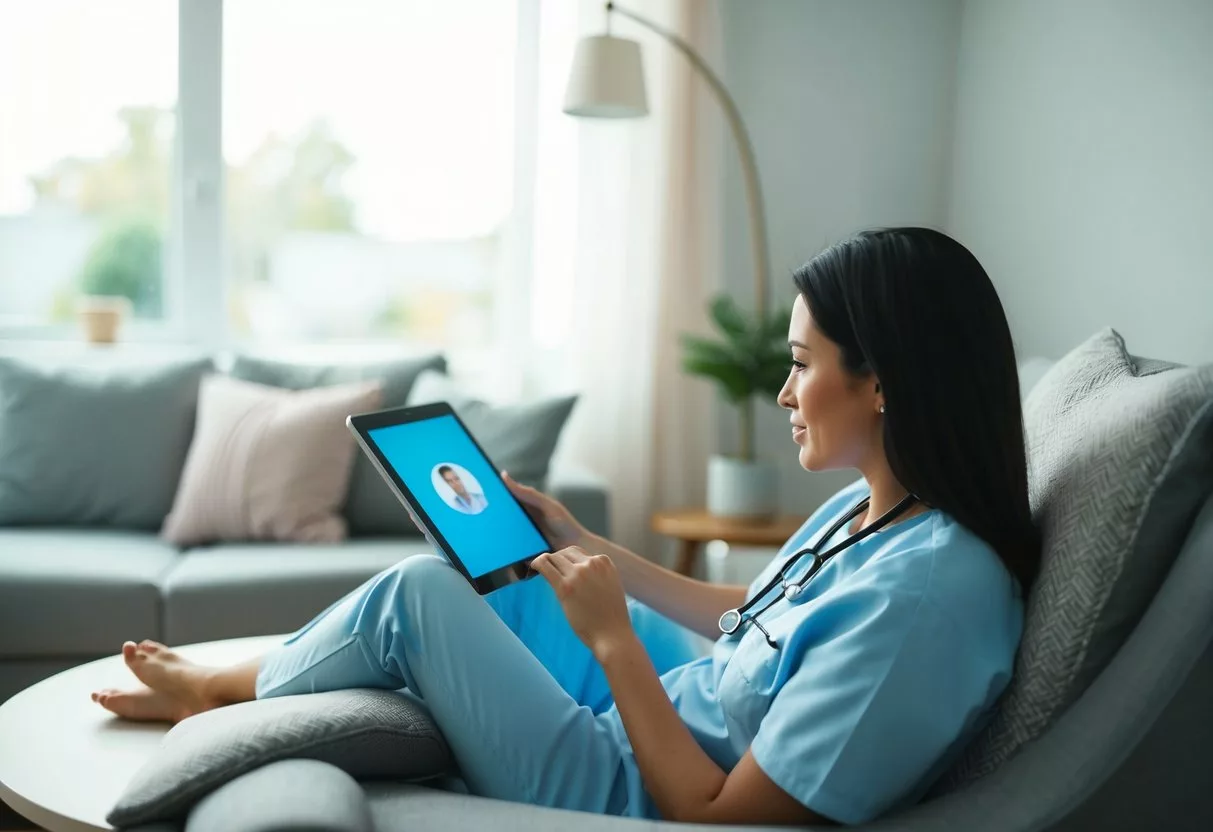Telemedicine has changed how people get healthcare. It lets patients talk to doctors without going to an office. This makes care easier to get for many people.

Telemedicine uses technology to connect patients and healthcare providers remotely. Patients can have video calls or phone chats with doctors. They can also send messages to ask questions. This works well for many health issues.
Telemedicine helps people who live far from doctors. It’s also good for those who have trouble leaving home. During the COVID-19 pandemic, it kept people safe while still letting them get care.
As technology improves, telemedicine will likely become even more common.
Evolution of Telemedicine Solutions

Telemedicine has transformed healthcare delivery over the decades. It has expanded access to care and improved patient outcomes through technological advances.
Historical Overview
Telemedicine has a long history, dating back to the early 20th century.
In 1906, the inventor of the electrocardiogram published a paper on the telecardiogram. Since the 1920s, radio has been used to give medical advice to clinics on ships. Alaska became a model for telemedicine development and use.
By 2016, an estimated 61% of US healthcare institutions used telemedicine. The market grew rapidly, expanding by 60% from 2012 to 2013.
Artificial intelligence integration has made telemedicine even more effective. AI helps simplify tasks, reduce doctor workloads, and boost job satisfaction.
Impact of the COVID-19 Pandemic
The COVID-19 pandemic accelerated telemedicine adoption dramatically. Stay-at-home orders and infection fears pushed patients and providers to embrace virtual care.
Telemedicine proved crucial for maintaining healthcare access during lockdowns. It allowed for safe consultations and reduced virus exposure risk.
Many regulations were relaxed to expand telemedicine use. Insurance coverage improved, and providers quickly adapted to virtual platforms.
The pandemic highlighted telemedicine’s potential to improve healthcare access and efficiency. It’s now seen as a permanent part of healthcare delivery, not just an emergency measure.
Key Components of Telemedicine

Telemedicine relies on several core technologies to connect patients and healthcare providers remotely. These tools enable virtual consultations, health tracking, and medication oversight.
Video Conferencing Technology
Video conferencing forms the backbone of many telemedicine solutions. It allows face-to-face interactions between doctors and patients from different locations.
High-quality video and audio are essential for accurate diagnoses. Many platforms work on smartphones, tablets, and computers, making them accessible to most people.
Secure, encrypted connections protect patient privacy during virtual visits. Some systems also support screen sharing, allowing doctors to review test results or medical images with patients in real-time.
Remote Monitoring Tools
Remote monitoring devices track patients’ health data at home. These tools send information to healthcare providers for analysis.
Common devices include:
- Blood pressure monitors
- Blood glucose meters
- Heart rate monitors
- Pulse oximeters
Wearable technology like smartwatches can continuously collect data on activity levels, sleep patterns, and heart rhythms. This gives doctors a more complete picture of a patient’s health over time.
Mobile apps often pair with these devices, making it easy for patients to log symptoms and share data with their care team.
Medication Management Systems
Digital medication management helps patients take the right drugs at the right times. These systems can improve treatment adherence and reduce errors.
Key features include:
- Automated reminders sent to phones or tablets
- Digital pill dispensers that track when medication is taken
- Apps for logging side effects or concerns
Some advanced systems use AI to predict potential drug interactions or adjust dosages based on patient data. This can help prevent adverse reactions and improve treatment outcomes.
Pharmacists can also use these platforms to provide virtual consultations, answering questions about medications and their effects.
Telemedicine Software Platforms

Telemedicine software platforms connect patients and healthcare providers remotely. They offer video calls, messaging, and record-keeping features. These tools help doctors give care from a distance.
Selecting the Right Software
When picking telemedicine software, think about what you need. Look for platforms with easy-to-use interfaces for both doctors and patients. Good video quality is key for clear communication.
Telemedicine software should have secure messaging and file sharing. This lets doctors and patients talk safely between visits. Check if the software works on phones and computers.
Some platforms offer extra tools like online booking and payment systems. These can make running a virtual practice easier. Compare prices and features to find the best fit for your budget.
Integration with Healthcare Systems
Telemedicine software needs to work well with other healthcare tools. Look for platforms that connect to electronic health records (EHRs). This helps keep patient info up-to-date and in one place.
Good integration means less work for doctors and staff. It can help schedule appointments and manage patient data. Some software can even link to medical devices for remote monitoring.
Check if the software follows health data rules like HIPAA. This keeps patient information safe and private. Ask about how the software handles billing and insurance claims too.
Telehealth in Practice

Telehealth has transformed healthcare delivery, offering new ways to connect patients and providers. It brings medical care directly into homes and remote areas, improving access and efficiency.
Telehealth Visits
Telehealth visits allow patients to consult with healthcare providers remotely. These virtual appointments use video calls, phone calls, or secure messaging.
Patients can discuss symptoms, get prescriptions, and receive follow-up care without leaving home. This is especially helpful for routine check-ups, minor illnesses, and chronic condition management.
Telehealth visits often lead to shorter wait times and reduced travel costs. They also limit exposure to other sick patients, which is crucial during outbreaks.
Specialized Care and Telestroke
Telehealth extends to specialized medical fields, including emergency stroke care. Telestroke services connect local emergency rooms with stroke specialists at larger hospitals.
This rapid connection allows for:
- Quick diagnosis
- Timely treatment decisions
- Expert guidance for local staff
Telestroke care can save lives by reducing the time to treatment. It’s particularly valuable in rural areas where stroke specialists may not be readily available.
Other specialized telehealth services include:
- Remote monitoring of heart conditions
- Virtual mental health counseling
- Dermatology consultations via high-resolution images
Support and Training for Healthcare Professionals
For telehealth to succeed, healthcare professionals need proper support and training. This includes:
- Technical training on telehealth platforms
- Guidelines for conducting effective virtual visits
- Education on telehealth best practices and etiquette
Healthcare organizations often provide ongoing support to address technical issues and improve telehealth skills. This ensures smooth virtual interactions and high-quality care.
Regular feedback and quality assessments help refine telehealth processes. They also identify areas where additional training or resources may be needed.
Benefits of Telemedicine

Telemedicine offers key advantages for patients and healthcare providers. It makes care more accessible, boosts efficiency, and improves communication between doctors and patients.
Expanding Healthcare Access
Telemedicine widens access to medical care, especially for people in rural areas. Patients can connect with specialists far away without long trips.
It helps those with limited mobility or transportation. Elderly patients and those with chronic conditions can get care from home.
Telemedicine also makes it easier to get mental health services. People can talk to therapists privately from their own homes.
Improving Healthcare Efficiency
Virtual visits save time for both patients and doctors. There’s no need to travel or sit in waiting rooms.
Doctors can see more patients in a day. This cuts down on wait times for appointments.
Telemedicine paired with AI can handle basic tasks. This frees up doctors to focus on complex cases.
Electronic health records make it easy to share info between providers. This leads to better coordinated care.
Enhancing Patient-Provider Communication
Video calls let doctors and patients talk face-to-face. This builds trust and understanding.
Patients can show symptoms or concerns visually. Doctors can demonstrate treatments or exercises.
Secure messaging systems allow quick follow-ups. Patients can ask questions between visits.
Regular virtual check-ins help manage chronic conditions. Doctors can catch problems early and adjust treatments.
Technological Advancements in Telemedicine

Telemedicine is evolving rapidly thanks to new technologies. These advances are changing how patients receive care and how doctors provide it.
Innovations in Telehealth Technology
Telehealth solutions now offer improved video quality and secure data transmission. High-definition cameras and faster internet speeds allow for clearer remote consultations.
Wearable devices track vital signs and send data to doctors in real-time. This helps with monitoring chronic conditions from afar. Mobile apps let patients schedule appointments, message providers, and access health records easily.
Virtual reality is being used for therapy and pain management. Augmented reality assists surgeons during complex procedures. These technologies expand what can be done remotely.
The Role of Artificial Intelligence
AI is transforming telemedicine capabilities. Machine learning algorithms analyze medical images to help detect diseases early. This supports faster, more accurate diagnoses.
Chatbots provide 24/7 patient support for basic health questions. They can also screen symptoms and recommend appropriate care levels.
AI tools help manage chronic conditions like diabetes by predicting blood sugar levels. This allows for personalized treatment plans. Natural language processing improves voice-based health assistants for elderly care.
Predictive analytics identify patients at risk for health issues. This enables proactive interventions before problems escalate.
Challenges Facing Telemedicine

Telemedicine faces major hurdles in access and regulation. These issues impact how healthcare providers can use remote technologies to treat patients effectively and legally.
Addressing the Digital Divide
The digital divide creates unequal access to telehealth services. Many rural and low-income areas lack high-speed internet. This makes video visits difficult or impossible.
Some patients don’t have smartphones or computers. Others struggle to use technology. Older adults often face the biggest barriers.
Healthcare providers are trying to bridge this gap. Some offer phone visits as an alternative. Others set up community telehealth hubs. These hubs give patients access to equipment and help.
Training programs teach digital skills to patients. Mobile clinics bring telehealth to underserved areas. Expanding broadband access is also key to solving this problem.
Regulatory and Legal Considerations
Telehealth regulations vary widely between states and countries. This creates confusion for providers offering remote care across borders.
Licensing is a major issue. Doctors usually need a license in the patient’s state. This limits access to specialists in other areas.
Patient privacy and data security are big concerns. Providers must use secure platforms that follow health privacy laws.
Insurance coverage for telehealth is still evolving. Many insurers expanded coverage during COVID-19. But long-term policies remain unclear.
Prescribing rules for telehealth differ by location. This affects how doctors can manage medications remotely.
Ensuring Quality and Safety in Telehealth Care

Telehealth care requires strong measures to protect patients and deliver high-quality treatment. Privacy safeguards and clear clinical guidelines are key to safe virtual care.
Maintaining Patient Privacy and Data Security
Protecting patient information is crucial in telehealth. Providers must use secure video platforms and encrypted messaging systems.
Strong passwords and two-factor authentication help keep data safe. Patients should be in private spaces during virtual visits.
Staff need training on proper handling of electronic health records. Regular security audits can find weak points in the system.
HIPAA rules still apply to telehealth. Providers must get patient consent before sharing any health data.
Clinical Guidelines and Best Practices
Clear guidelines for telehealth care help ensure quality. Providers should follow the same standards as in-person visits.
Virtual exams require proper lighting and camera angles. Doctors need training on how to assess patients remotely.
Some conditions may not be suitable for telehealth. Providers must know when to refer patients for in-person care.
Documentation is key. Detailed notes on virtual visits help with follow-up care.
Regular quality reviews can spot areas for improvement in telehealth programs.
Telehealth Accessibility and Patient Engagement

Telehealth has changed how people get healthcare. It makes care easier to get and helps patients stay connected with doctors.
Designing for User-Friendly Experiences
Telehealth solutions need simple interfaces. Clear buttons and easy-to-read text help patients use these tools.
Video calls should have good quality. This lets patients and doctors communicate well. Apps need to work on different devices like phones and computers.
Reminders help patients join appointments on time. Calendar links make scheduling simple. These features make telehealth more user-friendly.
Fostering Long-Term Patient Relationships
Regular check-ins keep patients engaged. Doctors can send quick messages to see how patients are doing.
Patient portals let people see their health info anytime. They can read lab results and ask questions.
Health care providers can share educational content. This helps patients learn about their conditions. It also builds trust between patients and doctors.
Virtual support groups connect patients with similar health issues. This creates a sense of community in telehealth care.
The Future of Telemedicine
Telemedicine is set to transform healthcare delivery in the coming years. New technologies and changing patient needs will shape how remote care evolves and expands.
Predicting Upcoming Trends
AI-powered telemedicine is expected to play a big role. Smart systems will help doctors diagnose and treat patients more accurately from afar.
Wearable devices will become more advanced. They’ll track vital signs and send real-time data to healthcare providers.
Virtual reality may enhance remote physical exams. Doctors could use VR to examine patients as if they were in the same room.
5G networks will enable smoother video calls and faster data transfers. This will improve the quality of virtual visits.
Preparing for Continued Evolution
Healthcare systems must stay flexible as telemedicine grows. They’ll need to update policies and train staff on new tools.
Cybersecurity will be crucial. As more health data moves online, protecting patient privacy will be a top concern.
Insurance companies may expand coverage for virtual care. This could make telemedicine more affordable and accessible.
Standardized protocols for telemedicine will likely develop. These will help ensure high-quality care across different platforms and providers.
Rural areas may see more investment in telemedicine infrastructure. This could help bridge healthcare gaps in remote regions.
Best Practices for Implementing Telehealth Services
Implementing telehealth services requires careful planning and execution. Key factors include adopting effective strategies and providing proper training for staff.
Strategies for Adoption and Scaling
Start by forming a telehealth committee with business, office staff, and clinical leaders. This group can create operational guidelines and align key stakeholders.
Choose telehealth solutions that connect patients and clinicians through real-time audio and video technology. These tools can serve as alternatives to in-person care in many cases.
For rural health providers, telehealth can bridge geographic gaps. It allows patients to access specialists without long travel times.
Develop clear protocols for when to use telehealth versus in-person visits. This helps ensure appropriate care delivery.
Training and Supporting Staff
Provide comprehensive training for all staff involved in telehealth services. This includes both clinical and administrative personnel.
Create easy-to-follow guides on using telehealth platforms. Make sure staff can troubleshoot common technical issues.
Offer ongoing support and refresher training. Technology and best practices evolve, so continuous learning is key.
Encourage staff to share feedback on the telehealth process. Use this input to refine and improve services over time.
Consider designating telehealth champions within the organization. These individuals can help drive adoption and assist colleagues.
Frequently Asked Questions
Telemedicine platforms offer many benefits for healthcare providers and patients. They improve access to care, enhance efficiency, and provide new ways to deliver medical services remotely.
What are the essential features of an effective telemedicine platform?
An effective telemedicine platform needs secure video conferencing. It should have easy scheduling and appointment management.
Electronic health record integration is important. The platform must comply with privacy regulations like HIPAA.
How does telemedicine improve patient care?
Telemedicine improves access to care for patients in rural areas. It reduces travel time and costs for patients.
Doctors can monitor patients with chronic conditions more frequently. This leads to better disease management and fewer complications.
What are the differences between synchronous and asynchronous telemedicine?
Synchronous telemedicine happens in real-time, like a video call. The doctor and patient interact directly.
Asynchronous telemedicine involves sharing information that is reviewed later. This includes sending images or test results for a doctor to examine.
Which telemedicine platforms offer the best value for small practices?
Many platforms cater to small practices with affordable pricing. Some popular options include Doxy.me, Zoom for Healthcare, and SimplePractice.
These platforms offer essential features without high costs. They are easy to set up and use for small teams.
How can healthcare providers ensure data security when using telemedicine software?
Providers should use HIPAA-compliant platforms. Encrypting all data transmissions is crucial.
Strong passwords and two-factor authentication help protect accounts. Regular staff training on security best practices is important.
What are the legal considerations to be aware of when deploying telemedicine services?
Providers must follow state and federal laws on telemedicine. This includes licensing requirements for treating patients across state lines.
Insurance and malpractice coverage should be reviewed. Providers also need informed consent from patients for telemedicine services.